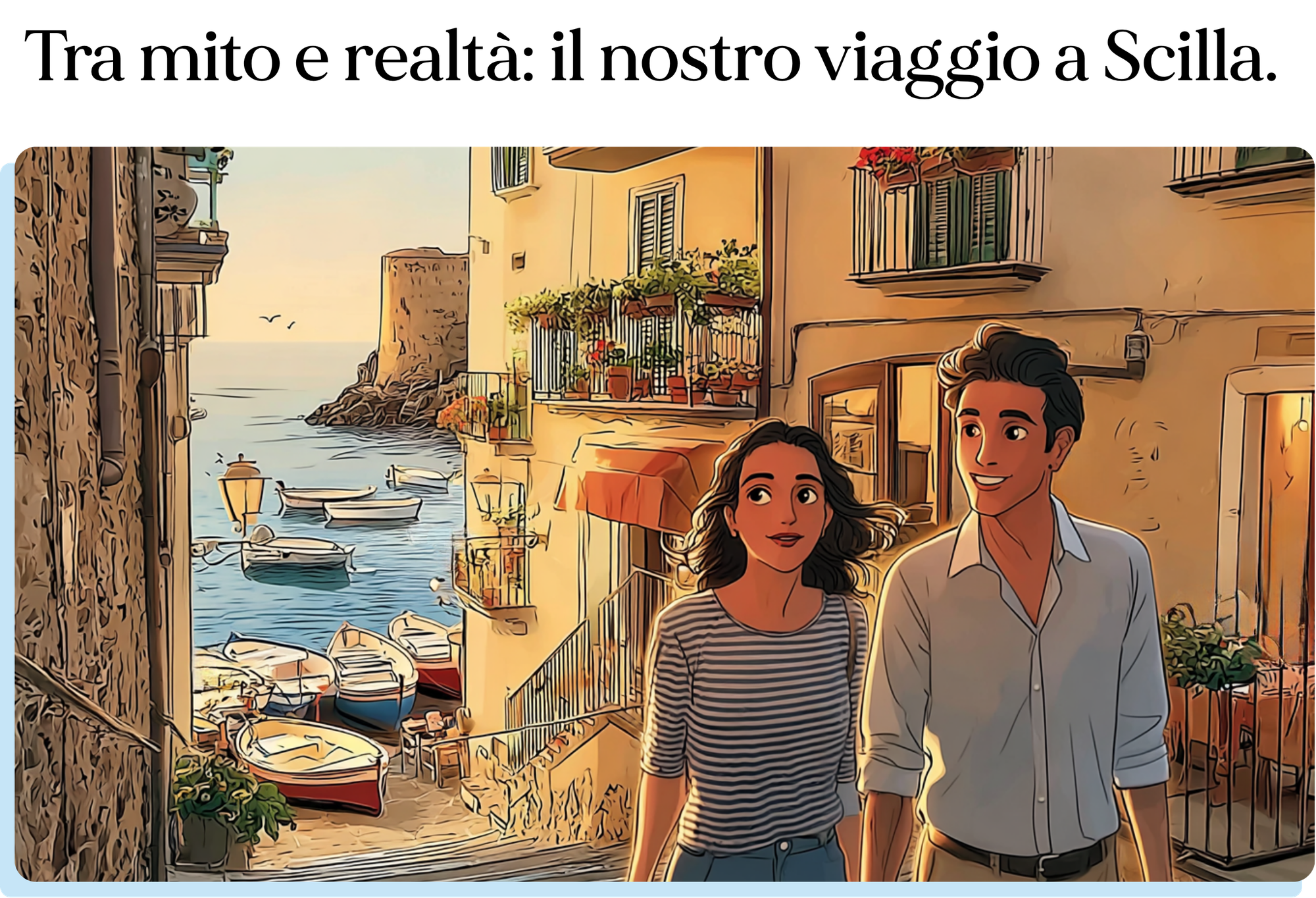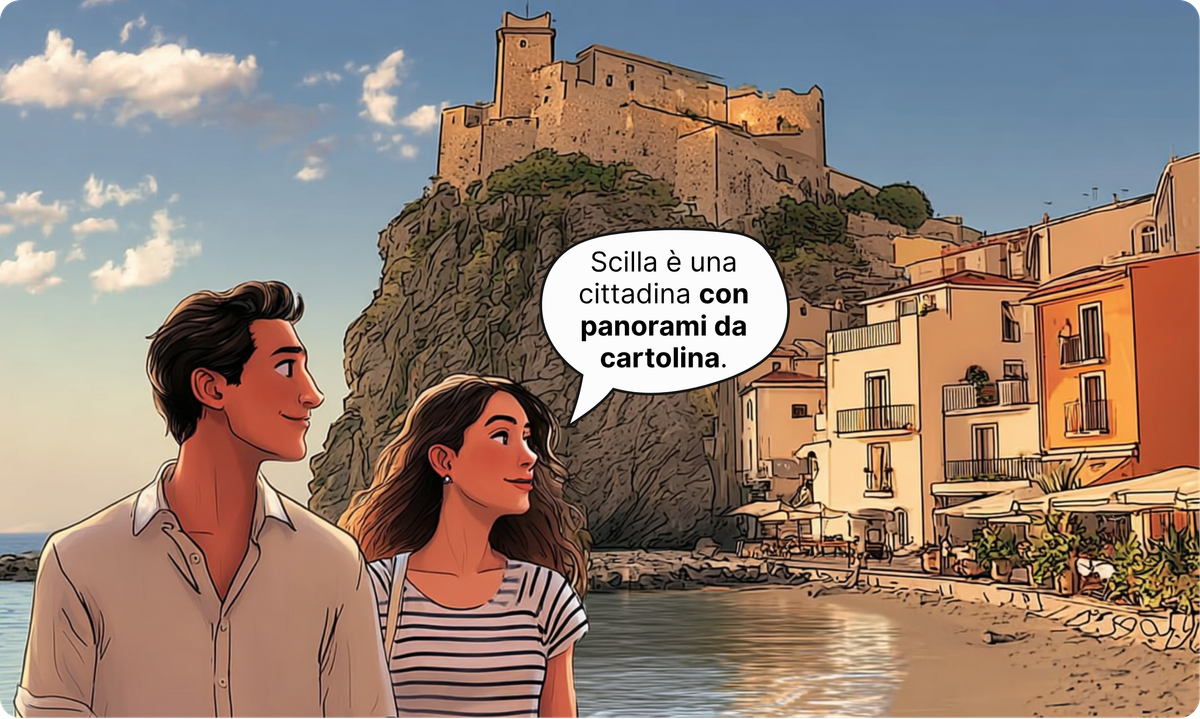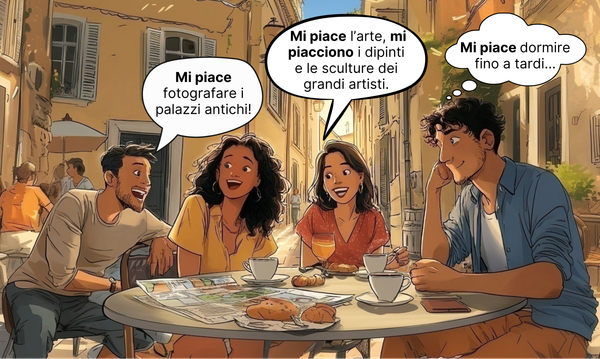Intro.
Prepositions for describing modo di essere (way of being) indicate how someone or something is. They're used to describe aspects like a person's characteristics or to describe the materials, functions, and style of objects and elements in our surroundings.
Prepositions for describing modo di fare (way of doing) indicate how an action takes place, specifying the manner or conditions.
1. Describing Appearance and Character
The prepositions that indicate a person's way of being allow us to specify how someone is with reference to physical appearance, behavior, clothing, and personality in general.
1.1 General Personal Traits
To indicate how a person is by giving an overall description of their appearance, we mainly use the preposition da:
• da + (art.) + noun + adjective.
Examples:
Siriano è un uomo dall'aspetto elegante.
Siriano is a man with an elegant appearance.
Giacomo è un bambino dall’aria birbante.
Giacomo is a mischievous-looking child.
Quella donna dall’espressione malinconica.
That woman with the melancholic expression.
1.2 Distinctive Physical Features
To indicate a particular trait of a person's appearance that refers to specific physical characteristics, we use the prepositions da and con equivalently:
- da / con + art. + noun + adjective (= "who has").
Examples:
La ragazza dagli/con gli occhi blu. → La ragazza che ha gli occhi blu.
The girl with blue eyes.
Il ragazzo dai/con i capelli scuri. → Il ragazzo che ha i capelli scuri.
The boy with dark hair.
Scusi, ha visto un signore dal/con il naso lungo? → Il signore che ha il naso lungo.
Excuse me, have you seen a man with a long nose?
1.3 Behavior
To indicate a trait of appearance or behavior that can be compared to generally known models, we use the preposition da:
- da + (adjective) + noun (= "like").
Examples:
Dario ha una faccia da bravo ragazzo. → come un bravo ragazzo.
Dario looks like a good guy.
Il signor Michelangelo si comporta da vero gentiluomo. → come un vero gentiluomo.
Mr. Michelangelo acts like a true gentleman.
Ti comporti sempre da maleducato. → come un maleducato.
You're always acting so rude.
Often the preposition da followed by a noun is also used to indicate a type of behavior that derives from a role or specific competence:
Examples:
Mattia parla da esperto nel suo settore.
Mattia speaks like an expert in his field.
Alice ci ha dato un suo parere da professionista in decorazione di interni.
Alice gave us her opinion as a professional in interior decoration.
1.4 Clothing
To indicate how a person is dressed, we use the preposition con followed by the name of the garment:
- con + garment name.
Examples:
Oggi Gianni è vestito con una giacca bordeaux.
Today Gianni is wearing a burgundy jacket.
Paola è uscita con una gonna lunga.
Paola went out in a long skirt.
1.4.1 Garment Characteristics
To indicate specific characteristics of a garment, we use the preposition a:
- a + noun (= "with/that has") – a fiori (floral); a maniche corte (short-sleeved); a righe (striped); a pois (polka-dotted); a vita alta (high-waisted); a collo alto (high-necked); a tinta unita (solid color).
Examples:
Per la festa hawaiana ho comprato una camicia a fiori. → una camicia con/che ha i fiori
For the Hawaiian party, I bought a flowered shirt.
Il maglione a collo alto ti sta davvero bene! → il maglione con/che ha il collo alto
The turtleneck sweater looks really good on you!
1.4.2 Garment Materials
To indicate the materials that garments are made of, we use the prepositions di and in equivalently:
• di / in + material – camicia di/in seta (silk shirt); maglione di/in lana (wool sweater); giacca di/in pelle (leather jacket); scarpe di/in cuoio (leather shoes)
Examples:
Per l’inverno ho un giacchetto di lana molto caldo.
For the winter, I have a very warm wool jacket.
D’estate indosso solo pantaloni in lino.
In the summer, I only wear linen pants.
1.5 Style
To indicate a style similar to that of a known character or group of people or category, we use the preposition alla:
• alla + character/category name (= "like/in the style of") – alla marinara (sailor-style); alla zuava (capri-style); alla coreana (Korean-style).
Examples:
Di solito preferisco indossare i pantaloni alla zuava perché sono larghi e molto comodi.
I usually prefer wearing capri pants because they're loose and really comfortable.
Sto cercando una giacca alla coreana.
I'm looking for a Korean-style jacket.
1.6 Figurative Use with the Preposition da
Prepositions used to indicate a way of being can describe moods, emotions, or sensations figuratively. Very common are figurative expressions with animals, where we mainly use the preposition da, which means "like," "similar to":
• da + common animal name.
Examples:
Una vita da cani.
A dog's life.
Oggi ho fame da lupi.
Today I'm as hungry as a wolf.
The preposition da highlights a relationship of similarity between a person's condition and that of a known figure like an animal. These expressions are very common in spoken language and emphasize the intensity of the mood or feeling being described.
2. Describing Objects, Buildings, and Surroundings
Prepositions of being allow us to indicate the characteristics of objects, buildings, and other elements of our surroundings. They're used to specify how objects are made, what materials compose them, their shape, structure, and other particularities.
2.1 Describing Objects, Buildings, or Environmental Elements
To indicate how an object, building, or physical element around us is, we use the prepositions con and a:
• con / a + noun.
Examples:
La casa di Samantha è arredata con mobili antichi.
Samantha's house is furnished with antique furniture.
Vivo in condominio a quattro piani.
I live in a four-story apartment building.
2.2 Architectural or Landscape Features
To indicate a specific architectural feature of a building or urban/landscape element, or a physical characteristic of an element around us, we use the prepositions da or con:
• da / con + noun + adjective.
Examples:
Vedi il palazzo dalle finestre gialle?
Do you see the building with the yellow windows?
Le isole del Pacifico dalle acque cristalline.
The Pacific islands with crystal-clear waters.
2.3 Construction Materials
To indicate the construction materials that objects, buildings, or elements around us are made of, we use the prepositions di and in:
• di / in + materiale – di/in vetro (glass); di/in legno (wood); di/in pietra (stone); di/in ceramica (ceramic); di/in acciaio (steel); di/in marmo (marble) → bicchiere di vetro (glass cup/glass); mattoni di ceramica (ceramic bricks); costruzioni in acciaio (steel constructions/steel buildings); statua di marmo (marble statue).
Examples:
Questo bicchiere è di vetro, fai attenzione.
This glass is made of glass, be careful.
Il tavolo in marmo è molto resistente.
The marble table is very sturdy.
2.4 Object Characteristics
To indicate specific characteristics of an object, when these refer to specific elements or objects, we use the preposition a:
• object + a + name of characterizing object/element – quaderno a righe/a quadretti (lined/grid notebook); colori a spirito/a tempera/a matita/a olio (marker/tempera/pencil/oil colors); letto a baldacchino/a castello/a due piazze (canopy/bunk/double bed); scala a pioli/a chiocciola (ladder/spiral staircase).
Examples:
Per prendere appunti uso un quaderno a righe.
I use a lined notebook to take notes.
Nella stanza dei bambini c’è un letto a castello.
In the children's room, there's a bunk bed.
2.5 Object Shape
To indicate the shape of an object that recalls a known shape, we use the construction a forma di:
• a forma di + noun.
Examples:
Un vaso a forma di tulipano.
A tulip-shaped vase.
Un cuscino a forma di cuore.
A heart-shaped cushion.
2.6 Object Style
To indicate the style with which a product, creative object, or way of acting is made, similar to the style of a renowned character, we use the articulated preposition alla followed by the name of the known character:
• alla + character name (= “like/in the style of”).
Examples:
Un libro alla Jane Austen.
→ con lo stile di Jane Austen.
A book in the style of Jane Austen.
Un quadro alla Van Gogh.
→ con lo stile di Van Gogh.
A painting in the style of Van Gogh.
The preposition alla is also used when referring to recognizable styles linked to a culture or artistic tradition: giardino all'italiana (Italian-style garden), giardino alla francese (French-style garden).
2.7 Special Functions of Objects and Places
To indicate a particular function of some objects or places, we use the prepositions da and a followed by the specific function. Often these word combinations constitute a unit with autonomous meaning:
• object + da + function (noun); – occhiali da sole/da vista (sunglasses/reading glasses); scarpe da ginnastica (sneakers); ferro da stiro (iron); bici da corsa (racing bike); sala da ballo (ballroom); pista da sci (ski slope).
Examples:
Mi passi i miei occhiali da sole, per favore?
Could you pass me my sunglasses, please?
Un tempo per scrivere si usavano le macchine da scrivere.
In the past, typewriters were used for writing.
• object + a + function (noun) - barca a vela (sailboat); sacco a pelo (sleeping bag); giacca a vento (windbreaker).
Examples:
Marco possiede una barca a vela bellissima.
Marco owns a beautiful sailboat.
Ho acquistato un sacco a pelo per il campeggio.
I bought a sleeping bag for camping.
2.8 Figurative Use with the Preposition da
The preposition da is often used for expressions that describe something exceptional or extraordinary that deserves great admiration. These expressions are very common in spoken language and emphasize the value and relevance of something or someone:
• da + noun (of prestigious prizes or recognitions).
Examples:
La performance dell’attore è stata da Oscar.
The actor's performance was Oscar-worthy.
L’impegno di Sara per i diritti umani è da Nobel.
Sara's commitment to human rights is Nobel-worthy.
3. Describing How Actions Are Done
Prepositions that express a way of doing describe the manner in which an action takes place, its quality and the circumstances in which it occurs.
3.1 How an Action Is Performed
To indicate the way an action is done or occurs, we mainly use the prepositions con, di, a:
• con + noun – indicates the quality with which an action is performed or occurs;
Examples:
Fai le cose con calma.
Do things calmly.
Ho risolto il problema con facilità.
I solved the problem with ease.
• di + noun – expresses a specific way of doing something;
Examples:
Non amo fare le cose di nascosto.
I don't like doing things secretly.
Vai sempre di fretta.
You are always in a hurry.
• a + noun – indicates the particular way an action is performed or occurs. Some expressions are fixed like festa a sorpresa (surprise party), a malincuore (reluctantly), a dovere (properly), a regola d'arte (to perfection).
Examples:
Hai fatto un lavoro a regola d’arte.
You did the work to perfection.
Le campane suonano a festa.
The bells are ringing in celebration.
3.2 Conditions of an Action
To describe the conditions in which an action occurs or someone finds themselves, we use the prepositions in and su:
• in + noun – indicates the state in which an action occurs or someone finds themselves;
Examples:
Lasci sempre la cameretta in disordine.
You always leave your room messy.
Siamo rimasti tutto il tempo in silenzio.
We stayed silent the whole time.
• su – indicates an action that is performed or occurs under a certain condition.
Examples:
L’articolo è disponibile solo su richiesta.
The article is available only upon request.
Ho agito su consiglio di un amico.
I acted on a friend’s advice.
4. Italian Prepositions for Describing Appearance and Actions in Context: Italian Short Story
The following short story demonstrates Italian prepositions for Describing Appearance and Actions in context. Notice how each preposition serves its specific function in describing appearance, clothing materials, architectural features, and ways of doing things. In the text below, Italian Prepositions for Describing Appearance and Actions are bolded to help you identify their usage patterns:

Dal blog Viaggi di Luisa
Cari amici del blog,
ci sono viaggi che iniziano tra i banchi di scuola, alcuni restano chiusi nei libri, tra note scritte a matita e pagine sottolineate, altri invece prendono vita.
Il nostro viaggio a Scilla, in Calabria, è stato proprio questo: un ritorno al tempo in cui eravamo studenti, più che una partenza. La cittadina prende il nome da Scilla, una ninfa dalla bellezza ammaliante che abitava questi luoghi, trasformata in un mostro marino dall’aspetto spaventoso e crudele. Il mito che avvolge Scilla, tragico e ricco di fascino, ha sempre suscitato in me meraviglia e inquietudine. Anticamente nel mito, di fronte a Scilla stava Cariddi un’altra ninfa dal destino tragico.
Oggi Scilla è una cittadina con panorami da cartolina. Si affaccia sullo Stretto di Messina, proprio sulla punta dello stivale. Giungendo in barca, appare subito il Castello Ruffo, maestoso, a picco sul mare, dalle mura imponenti. Il quartiere di Chianalea, dove abbiamo passeggiato, è un gioiello in pietra: è chiamato la “Venezia del Sud”, con i suoi vicoli silenziosi, le case con i balconi pieni di fiori, le stradine ricoperte di ciottoli.
La sera, seduti in spiaggia con i piedi nella sabbia, abbiamo recitato interi brani di letteratura greca che a scuola abbiamo imparato a memoria e così abbiamo ricordato anche il nostro professore, un uomo dall’aria austera, sempre vestito con giacca e cravatta, anche in estate. Ricordo che spiegava con voce stentorea e noi lo ascoltavamo con grande attenzione. Era severo, ma giusto.
In questo viaggio ho ritrovato tante cose: la me studentessa con lo spirito coraggioso e curioso; Pietro, l’adolescente spensierato con gli occhi pieni di vita. Ricordando i tempi della scuola, mi accorgo che nei nostri sguardi da ragazzi ingenui di quel tempo c’era già tutto: la voglia di scoprire, il desiderio di esplorare.
Amici… viaggiare a sud vuol dire attraversare il tempo e percorrere i luoghi del mito, lasciare emergere i ricordi, diventare sentimentali, come sono stata in questo lungo post. Ma come farne a meno? Ogni viaggio, alla fine, è sempre un ritorno.
Senza sentimentalismo e con molto senso pratico vi lascio un piccolo consiglio. Lo stretto di Messina anticamente popolato da Scilla e da Cariddi rimane un passaggio di mare ventoso e a volte burrascoso, quindi quando andrete, indossate sempre una maglia o una camicia a maniche lunghe, e portate un bel maglione di cotone. Pietro che ha voluto indossare una camicia di lino ha adesso un bel raffreddore! Io con una semplice maglietta alla marinara ho trascorso la notte in bianco per i brividi di freddo!
A presto e con affetto,
Luisa
Ps. Ho una domanda per voi: conoscete il blog di Giulia? No? Ne parliamo un’altra volta!
5. Test Your Knowledge: Grammar Quiz
Test your understanding of Italian Prepositions for Describing Appearance and Actions with these practice exercises designed to reinforce the concepts covered in this comprehensive guide.
6. Frequently Asked Questions (FAQ) 🙋♀️
Is there a difference between the preposition con and the preposition da to indicate a particular trait of a person's appearance?
Both prepositions are used to describe physical traits, but there's a small nuance of meaning, based on their use.
The preposition con indicates a direct relationship, almost of belonging, between the person and the physical trait that characterizes them: e.g., Una ragazza con gli occhi verdi (A girl with green eyes).
The preposition da highlights the effect that a physical characteristic has on the person's overall appearance, almost like a distinctive quality: e.g., Una ragazza dai capelli rossi (A girl with red hair).
To describe a person's behavior, can you use con instead of da?
Yes, but there's a difference.
When con is used, the preposition indicates a direct quality of the person, as in the sentence Antonio si comporta con gentilezza (Antonio behaves with kindness).
The preposition da, instead, indicates a similarity with someone or something's specific behavior, as in the sentence Antonio si comporta da vero gentiluomo (Antonio behaves like a true gentleman).
The preposition con is followed by the name of an abstract quality, the preposition da is followed by a noun that identifies a person.
How do you use the prepositions a and con to describe clothing?
The preposition con is used to indicate the garment a person is wearing: e.g., Paola è uscita con una giacca elegante (Paola went out with an elegant jacket).
The preposition a is used to specify the characteristics of a garment: e.g., Una camicia a righe (A striped shirt); Un vestito a maniche corte (A short-sleeved dress).
The preposition con is followed by the name of a clothing item, the preposition a is followed by nouns that identify the characteristics of the clothing item.

Adriana Rossi is a certified teacher of Italian as a foreign language from Rome, Italy, and has been part of the Giulia team since 2024. With a Modern Literature degree and advanced studies in Modern Philology, she specializes in tracing the origins and evolution of Italian words, bringing expertise in diction and expressive reading to help preserve and share Italy’s linguistic heritage with learners worldwide.





